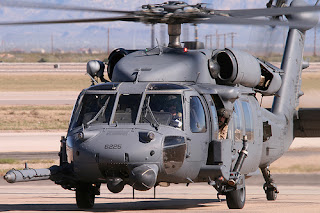Sikorsky HH-60G Pave
Hawk is a twin turboshaft engine helicopter in service with the United States
Air Force. It is a derivative of the UH-60 Black Hawk and incorporates the US
Air Force PAVE electronic systems program. The HH/MH-60 is a member of the
Sikorsky S-70 family. The MH-60G Pave Hawk's primary mission is insertion and
recovery of special operations personnel, while the HH-60G Pave Hawk's core
mission is recovery of personnel under stressful conditions, including search
and rescue. Both versions conduct day or night operations into hostile
environments. Because of its versatility, the HH-60G may also perform
peace-time operations. Such tasks include civil search and rescue, emergency
aeromedical evacuation (MEDEVAC), disaster relief, international aid,
counter-drug activities and NASA space shuttle support.
In 1981, the U.S. Air Force
chose the UH-60A Black Hawk to replace its HH-3E Jolly Green Giant helicopters.
After acquiring some UH-60s, the Air Force began upgrading each with an air
refueling probe and additional fuel tanks in the cabin. The machine guns were
changed from .308 in (7.62 mm) M60s to 0.50 in (12.7 mm) XM218s. These
helicopters were referred to as "Credible Hawks" and entered service
in 1987. Afterward, the Credible Hawks and new UH-60As were upgraded and
designated MH-60G Pave Hawk. These upgrades were to be done in a two step
process. But funding only allowed 16 Credible Hawks to receive the second step
equipment. These helicopters were allocated to special operations use. The
remaining 82 Credible Hawks received the first step upgrade equipment and were
used for combat search and rescue. In 1991, these search and rescue Pave Hawks
were redesignated HH-60G. The Pave Hawk is a highly-modified version of the
Sikorsky UH-60 Black Hawk. It features an upgraded communications and
navigation suite that includes an integrated inertial navigation/global
positioning/Doppler navigation systems, satellite communications, secure voice,
and Have Quick communications.
All HH-60Gs have an
automatic flight control system, night vision goggles lighting and forward
looking infrared system that greatly enhances night low-level operations.
Additionally, some Pave Hawks have color weather radar and an engine/rotor
blade anti-ice system that gives the HH-60G an all-weather capability. Pave
Hawk mission equipment includes a retractable in-flight refueling probe,
internal auxiliary fuel tanks, two crew-served (or pilot-controlled) 7.62 mm
miniguns or .50-caliber machine guns and an 8,000 pound (3,600 kg) capacity
cargo hook. To improve air transportability and shipboard operations, all HH-60Gs
have folding rotor blades. Pave Hawk combat enhancements include a radar
warning receiver, infrared jammer and a flare/chaff countermeasure dispensing
system. HH-60G rescue equipment includes a hoist capable of lifting a 600 pound
(270 kg) load from a hover height of 200 feet (60 m), and a personnel locating
system. A limited number of Pave Hawks are equipped with an over-the-horizon
tactical data receiver that is capable of receiving near real-time mission
update information.
The U.S. Air Force
HH-60G Pave Hawk is operated by the Air Combat Command (ACC), U.S. Air Forces
in Europe (USAFE), Pacific Air Forces (PACAF), Air Education and Training
Command (AETC), the Air Force Reserve Command (AFRC) and the Air National Guard
(ANG) as of 2011. During Operation Desert Storm, Pave Hawks provided combat
search and rescue coverage for coalition Air Forces in western Iraq, Saudi
Arabia, coastal Kuwait and the Persian Gulf. They also provided emergency
evacuation coverage for U.S. Navy sea, air and land (SEAL) teams penetrating
the Kuwaiti coast before the invasion.
All MH-60Gs subsequently
divested by AFSOC; most MH-60Gs were redesignated as HH-60Gs in 1991 and
transferred to Air Combat Command (ACC) and ACC-gained Air Force Reserve
Command (AFRC) and Air National Guard (ANG) units. During Operation Allied
Force, the Pave Hawk provided continuous combat search and rescue coverage for
NATO air forces, and successfully recovered two U.S. Air Force pilots who were
isolated behind enemy lines. In March 2000, three Pave Hawks deployed to
Hoedspruit Air Force Base in South Africa, to support international flood
relief operations in Mozambique. The HH-60Gs flew 240 missions in 17 days and
delivered more than 160 tons of humanitarian relief supplies. Air Force Pave Hawks
from the Pacific theater also took part in a massive humanitarian relief effort
in early 2005 in Sri Lanka to help victims of the tsunami. In the fall of 2005,
Pave Hawks from various Air Force commands participated in rescue operations of
Hurricane Katrina survivors, rescuing thousands of stranded people. Pave Hawks
have regularly operated in Operation Enduring Freedom and Operation Iraqi
Freedom supporting Army and Marine Corps ground combat operations and standby
search and rescue support for U.S. and Coalition fixed-wing combat aircraft
supporting those ground operations. In March 2010, the U.S. Air Force announced
a recapitalization plan to return its 99-aircraft inventory to 112 airframes by
incremental replacement aging HH-60Gs. A secondary plan for loss replacement of
thirteen attrited HH-60s, seven of which have been lost in combat since 2001,
has begun implementation. The Air Force is deferring secondary combat search
and rescue requirements that called for a larger helicopter. A UH-60M-based
version was being offered as a replacement.
DISCLAIMER: The
material content provided on this page is generated by another sources and
consequently features user-generated content. While we do our best to stop
offensive material appearing, ekotriyanggono.com cannot be held responsible for
all of the material that may be displayed on this page. If you object to any
article or picture, please leave us a comment in this page.


No comments:
Post a Comment